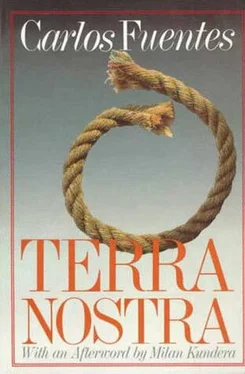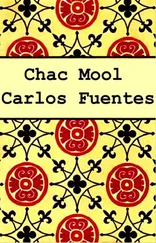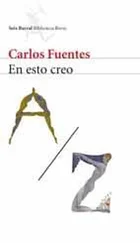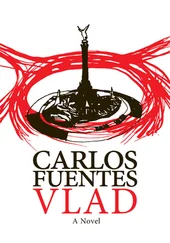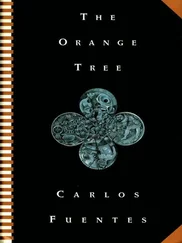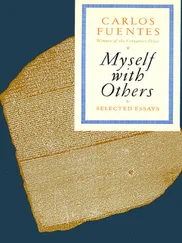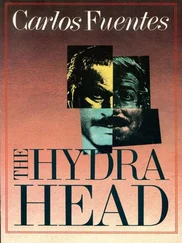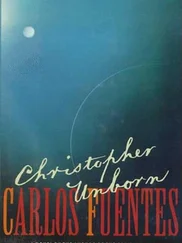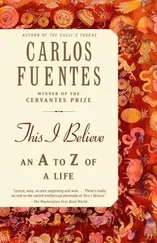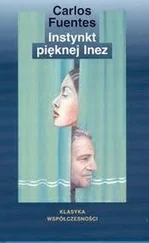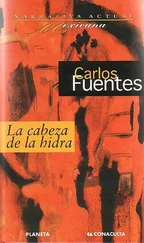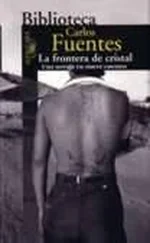The painting: The Christ without a halo, standing in the angle formed by the temple walls, looks at the naked men whose backs are turned to the viewer. The arcades of the vast, clean, open piazza are contemporary, characteristic of the new airy architecture of the Italian peninsula; the diligent eye might note small flaws in the painted marble floor, minute cracks, scratches, shoots, and sprouts of grass; the piazza is of the age. But from what age are the scenes in a background lost in the distance of deep perspectives and echoing a remote chorus to the protagonists on the proscenium of this sacred theater — a Christ without an aureole, and a group of naked men? Minute, remote scenes, lost in time, the profound perspectives of this painted space distance those scenes, convert them into remote time.
El Señor flung himself upon the polished granite floor, his arms spread in a cross; and on the back of his cape the yellow embroidered cross recaptured what little luminosity was shed by an altar intricately carved and ornamented to house the monstrance from which this isolated light originates; light shimmers on a jasper plinth shot with golden veins, on columns so fine and hard that no tool, not even the best-tempered steel, had been found that could cut them; they had been cut and polished with diamonds. El Señor’s forehead was resting on an icy floor which, like the light, seemed enormously remote from the parched ground and all-pervasive sun overhead; above this crypt and chapel lay dry dust as hot as ashes. At the far end of the extensive sacred space, an uncompleted stairway began an ascent that was to lead to the burning plain overhead. His head pressed against cold granite, feverish images El Señor preferred to forget raced through his mind. And he did forget them, by contemplating the unfinished stairway behind him, and thinking about his immediate duty: to bring this construction to a conclusion, but to avoid the Greek arrogance of an Alexander who ordered that Mount Athos be cut and carved in his own image; here, in Spanish mansions imitating those of Heaven, day and night the same, one might continually engage in the occupation of angels, with continuous prayers one might pray for the health of Princes, the conservation of their estates, one might mitigate divine ire and justly deserved rage against the sins of man; such, in this hour, was the supplication of El Señor, for his mind could not conceive of separation between religious and political affairs, knowing as he did that of all the virtues that regulate human actions the queen of all is prudence; and that among the varieties of prudence, the one that best serves a Prince is politics: St. Basil laments that some defame politics under the improper appellations of artifice and cunning, and never perceive that acts of cunning and of artifice are daughters of the deadly prudence of the flesh, not of the spirit, for from spiritual prudence derives the life and peace of kingdoms. To this peace, now — the cunning of his youth, the artifices of the flesh, the simulations of war, behind him — El Señor aspired in his humble prayer. And what better mark of the union of prudence and politics than to construct a monument, which means, after all, “something to remind”; monumentum dicitur, eo quod moneat mentem? according to the words of St. Augustine. And this being so, can there be any true monument that does not convert political prudence into religious glory, since no man who takes counsel in this life loses the eternal?
The painting: In the sixth month the angel Gabriel was sent from God unto a city of Galilee, named Nazareth, to a virgin espoused to a man whose name was Joseph, of the house of David; and the virgin’s name was Mary. And the angel came in unto her, and said, Hail, thou that art highly favoured, the Lord is with thee. She was troubled at his saying, and the angel said unto her, Fear not, Mary: for thou hast found favour with God. And, behold, thou shalt conceive in thy womb, and bring forth a son, and shalt call his name Jesus. He shall be great, and shall be called the Son of the Highest: and the Lord God shall give unto him the throne of his father David: And he shall reign over the house of Jacob for ever: and of his kingdom there shall be no end.
The palace: The emissaries have traveled throughout the continent commissioning the treasures that, by contrast, will enliven the somber majesty of the palace under construction. Either already obtained or still on the road, waiting in improvised storerooms or about to arrive on beasts of burden, everyone knew that the iron grill work was forged in Cuenca and the bronze balustrades in Zaragoza; that the gray, white, green, and red marbles were extracted from veins in Spain and Italy; that the bronze altar figures were cast in Florence and those for the mausoleums in Milan; that the candelabra arrived from Flanders, and the censers and crosses from Toledo, and that the altarcloths, surplices, albs, purificators, Rouen and Holland linens, and India silk were embroidered in Portuguese convents. El Señor covered his face with the wounded hand bound in a linen handkerchief embroidered by the Holy Sisters in Alcobaça. The religious paintings had been painted in Brussels and in Colmar, in Ravenna and in Hertogenbosch. And the painting he had spent the morning contemplating had come from Orvieto. People were talking: Hertogenbosch, the evil bosk where the Adamite sects had celebrated their Eucharistic orgies, transforming each body into the altar of Christ and each carnal coupling into redeeming Communion. Orvieto, no one denied it, was the ancient Etruscan Volsinii conquered by the Romans and converted into Urbs Vetus, site of a black and white cathedral, and fatherland to austere, sad, and prolific painters.
The painting: And Joseph also went up from Galilee, out of the city of Nazareth, into Judea, unto the city of David, which is called Bethlehem, to be taxed with Mary his espoused wife, being great with child. And so it was, that, while they were there, the days were accomplished that she should be delivered. And she brought forth her firstborn son, and wrapped him in swaddling clothes, and laid him in a manger; because there was no room for them in the inn. And there were in the same country shepherds abiding in the field, keeping watch over their flock by night. And, lo, the angel of the Lord came upon them, and said unto them, Fear not; for, behold, I bring you good tidings of great joy, which shall be to all people. For unto you this day is born in the city of David a Saviour, which is Christ the Lord. When Herod the king had heard these things, he was exceeding wroth, and sent forth, and slew all the children that were in Bethelem, from two years old and under, but behold, the angel of the Lord appeareth to Joseph in a dream, saying, Arise, and take the young child and his mother, and flee to Egypt. And they were there until the death of Herod: that it might be fulfilled which was spoken of the Lord by the prophet, saying, Out of Egypt have I called my son.
The dog Bocanegra could move his bandaged head with his accustomed nervousness, but not his ears. And perhaps the fresh wound, the roughly stitched flesh, and the pressure of the compress made him doubt his own instincts. Lying by his master’s side, he looked toward the nuns’ choir loft hidden behind a high iron chancel.
Guzmán was watching from a place of concealment behind a column, counting on the knowledge that the dog was familiar with his scent and fearful of his hand. And behind the intricate grill work of the choir loft, La Señora will spend many hours watching without being observed. At first the mastiff’s muffled growls had disturbed her, but finally she told herself that Bocanegra’s fear must be the result of something he had seen rather than fear of anything unseen. Like the dog, La Señora was watching her master, stretched out upon the floor, face down, his arms spread in a cross, his lips murmuring professions of faith, with the light from the altar reflecting on the embroidered cross on his back. Like her husband, La Señora was motionless, but she stood erect, more erect than ever (Guzmán wished to penetrate the invisibility of that chancel), more conscious than ever (because no one was watching her) of the value of a gesture and of the intrinsic dignity of a posture; she was enveloped in shadow, and once again she regretted the fact no one was witnessing her magnificent picture of majestic ire. She, too, was looking at one of the background scenes in the painting.
Читать дальше
